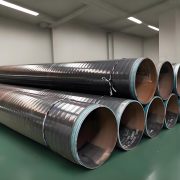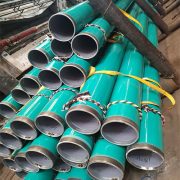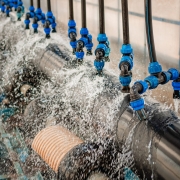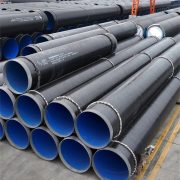Choosing the Right Coatings: 3LPE Coating vs FBE Coating
Introduction
In the oil, gas, and water transmission industries, pipeline coatings play a crucial role in ensuring the long-term performance and protection of buried or submerged pipelines. Among the most widely used protective coatings are 3LPE (Three-Layer Polyethylene Coating) and FBE (Fusion Bonded Epoxy Coating). Both provide corrosion resistance and mechanical protection, but they offer distinct advantages depending on the application environment. Understanding their differences is essential for making an informed decision in pipeline coating selection. 3LPE coating vs FBE coating, let’s explore in-depth.
1. Overview of 3LPE Coating vs FBE Coating
3LPE Coating (Three-Layer Polyethylene Coating)
3LPE is a multi-layered protective system that combines different materials to create an effective shield against corrosion and physical damage. It consists of three layers:
- Layer 1: Fusion Bonded Epoxy (FBE): This provides strong adhesion to the pipe surface and offers excellent corrosion resistance.
- Layer 2: Copolymer Adhesive: The adhesive layer bonds the epoxy layer to the outer polyethylene layer, ensuring a strong bond.
- Layer 3: Polyethylene (PE): The final layer offers mechanical protection from impacts, abrasions, and environmental conditions.
FBE Coating (Fusion Bonded Epoxy Coating)
FBE is a single-layer coating made from epoxy resins that are applied in a powder form. When heated, the powder melts and forms a continuous, highly adherent layer around the pipe surface. FBE coatings are primarily used for corrosion resistance in environments that may expose the pipeline to water, chemicals, or oxygen.
2. 3LPE Coating vs FBE Coating: Understanding the Differences
| Feature | 3LPE Coating | FBE Coating |
|---|---|---|
| Structure | Multi-layer (FBE + adhesive + PE) | Single-layer epoxy coating |
| Corrosion Resistance | Excellent, due to the combined barrier of FBE and PE layers | Very good, provided by epoxy layer |
| Mechanical Protection | High impact resistance, abrasion resistance, and durability | Moderate; susceptible to mechanical damage |
| Operating Temperature Range | -40°C to +80°C | -40°C to +100°C |
| Application Environment | Suitable for harsh environments, including offshore and buried pipelines | Ideal for buried or submerged pipelines in less harsh environments |
| Application Thickness | Typically thicker, due to multiple layers | Typically thinner, single-layer application |
| Cost | Higher initial cost due to multi-layer system | More economical; single-layer application |
| Longevity | Provides long-term protection in aggressive environments | Good for moderate to less aggressive environments |
3. Advantages of 3LPE Coating
3.1. Superior Corrosion and Mechanical Protection
The 3LPE system offers a robust combination of corrosion protection and mechanical durability. The FBE layer provides excellent adhesion to the pipe surface, acting as the primary barrier against corrosion, while the PE layer adds additional protection from mechanical stresses, such as impacts during installation and transportation.
3.2. Ideal for Buried and Offshore Pipelines
3LPE coatings are particularly well-suited for pipelines that will be buried underground or used in offshore environments. The outer polyethylene layer is highly resistant to abrasions, chemicals, and moisture, making it ideal for long-term performance in harsh conditions.
3.3. Extended Lifespan in Aggressive Environments
Pipelines coated with 3LPE are known for their longevity in aggressive environments such as coastal areas, high-salt regions, and locations prone to soil movement. The multi-layered protection ensures resistance to moisture penetration, soil contaminants, and mechanical damage, reducing the need for frequent maintenance.
4. Advantages of FBE Coating
4.1. Excellent Corrosion Resistance
Despite being a single-layer coating, FBE provides excellent resistance to corrosion, particularly in less harsh environments. The fusion-bonded epoxy layer is highly effective at preventing moisture and oxygen from reaching the steel pipe surface.
4.2. Heat Resistance
FBE coatings have a higher operating temperature limit compared to 3LPE, making them suitable for pipelines exposed to higher temperatures, such as in certain oil and gas transmission lines. They can operate in temperatures up to 100°C, compared to 3LPE’s typical upper limit of 80°C.
4.3. Lower Application Costs
Since FBE is a single-layer coating, the application process is less complex and requires fewer materials than 3LPE. This makes FBE a cost-effective solution for pipelines in less aggressive environments, where high-impact resistance is not critical.
5. 3LPE Coating vs FBE Coating: Which One Should You Choose?
5.1. Choose 3LPE When:
- The pipeline is buried in harsh environments, including coastal regions or areas with high soil moisture content.
- High mechanical protection is needed during handling and installation.
- Long-term durability and resistance to environmental factors like water and chemicals are required.
- The pipeline is exposed to aggressive environments where maximum corrosion protection is essential.
5.2. Choose FBE When:
- The pipeline will be operating at higher temperatures (up to 100°C).
- The pipeline is not exposed to severe mechanical stresses, and corrosion protection is the primary concern.
- The application requires a more economical solution without compromising corrosion resistance.
- The pipeline is located in less aggressive environments, such as low-salt soils or moderate climate areas.
6. 3LPE Coating vs FBE Coating: Challenges and Limitations
6.1. Challenges with 3LPE
- Higher Initial Costs: The multi-layer system involves more materials and a more complex application process, resulting in higher initial costs.
- Thicker Coating: While this adds durability, the thicker coating may require more space in certain applications, especially in tightly confined pipeline installations.
6.2. Challenges with FBE
- Lower Mechanical Strength: FBE coatings lack the robust mechanical protection provided by 3LPE, making them more susceptible to damage during handling and installation.
- Moisture Absorption: Although FBE provides good corrosion resistance, its single-layer design makes it more prone to moisture ingress over time, particularly in aggressive environments.
7. Conclusion: Making the Right Choice
Choosing between 3LPE and FBE coatings depends on the specific conditions and requirements of the pipeline. 3LPE is ideal for harsh environments where long-term durability and mechanical protection are priorities, while FBE offers a cost-effective solution for environments where corrosion resistance is the main concern and mechanical stresses are moderate.
By understanding the strengths and limitations of each coating, pipeline engineers can make informed decisions to maximize the longevity, safety, and performance of their transmission systems, whether transporting oil, gas, or water.








